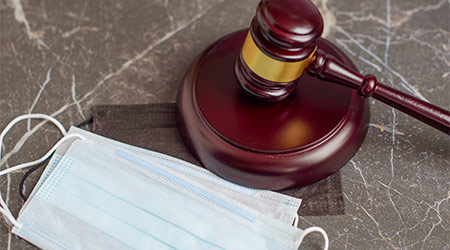Throughout the pandemic, the Occupational Safety & Health Administration (OSHA) has issued a number of guidance documents surrounding infection prevention and worker safety, including the “Guidance on Preparing Workplaces for COVID-19.” However, federal OSHA has not issued any federal emergency standards specific to SARS-CoV-2. While these guidance documents represent the industry standard of care, they do not create the same legal obligations for employers that a regulation would mandate.
Therefore, to curtail the increase in COVID-19 cases, a handful of the 28 states with OSHA-approved State Plans have begun implementing their own Emergency Temporary Standards. Virginia led the country in July by enacting an Emergency Temporary Standard to protect workers against the spread of COVID-19. Several months later Michigan, Oregon and California followed suit by implementing mandatory health and safety standards to help protect workers against the spread of SARS-CoV-2.
While each of the state standards have differences, the majority of these emergency temporary state standards coincide with aspects of OSHA’s federal guidance that recommends the employer implement the following in accordance with their written plan.
• Communication to employees about the employer’s COVID-19 prevention procedures
• Identify, evaluate and correct COVID-19 hazards
• Physical distancing of at least six feet unless it is not possible
• Use of face coverings
• Use engineering controls, administrative controls and personal protective equipment as required to reduce transmission risk
• Procedures to investigate and respond to COVID-19 cases in the workplace
• Provide COVID-19 training to employees
• Provide testing to employees who are exposed to a COVID-19 case, and in the case of multiple infections or a major outbreak, implement regular workplace testing for employees in the exposed work areas
• Exclusion of COVID-19 cases and exposed employees from the workplace until they are no longer an infection risk
• Maintain records of COVID-19 cases and report serious illnesses and multiple cases as required
Of note, the majority of hospitals have already established infectious disease programs and invest significant resources to assess and improve infection prevention and response. Since hospitals participate in the Medicare and Medicaid programs, they must meet specific infection control requirements as set by the programs’ conditions of participation. In doing so, most hospitals already adhere to science-based guidance from the U.S. Centers for Disease Control and Prevention (CDC) and Centers for Medicare & Medicaid Services (CMS), as they track any developments and update its standards accordingly as information becomes available.
Due to the changes in regulation and industry standard of care, however, it would be wise for hospitals to review their current programs and incorporate any updates into their currently-existing programs, specific to COVID-19. All sectors of healthcare, including long-term care facilities, home health services, clinics, medical offices, and other outpatient medical services, should evaluate their infection control programs for compliance.
On the federal level, during the 116th U.S. Congress, legislation requiring OSHA to issue an Emergency Temporary Standard to protect all workers from exposure to COVID-19 in the workplace, was introduced. While the bill did not pass, The COVID–19 Every Worker Protection Act of 2020 (H.R. 6559) would have:
• Required OSHA to issue an Emergency Temporary Standard within seven days that covers all workers and requires all workplaces to implement infectious disease exposure control plans to keep workers safe during the COVID-19 pandemic.
• OSHA would have been required to issue a permanent comprehensive infectious disease standard within two years.
• Required OSHA to forbid employers from retaliating against workers for reporting infection control problems to their employer, any public authority, to the media or on a social media platform.
• The standard would have also forbid employers from retaliating against workers for using their own higher level personal protective equipment if the employer does not provide it.
• Protected public employees across the country by requiring the 24 states where public employees are not currently covered by OSHA to adopt the ETS within 14 days of enactment;
• Required CDC and the National Institute for Occupational Safety and Health to track and investigate work-related COVID-19 infections and make recommendations on needed actions or guidance to protect such employees.
• Given OSHA the discretion not to issue citations to hospitals and other covered employers due to shortages of equipment, if:
- The employer showed that they were making a good-faith effort to purchase personal protective equipment and come into compliance, and
- The employer was implementing alternative methods to protect its employees.
The Biden campaign has stated that the development of an emergency temporary standard is a priority. Efforts are already underway to support this bill when it is reintroducing in the new Congress.
Shari L. Solomon, Esq. is president and founder of CleanHealth Environmental, LLC. CleanHealth provides infection prevention and industrial hygiene training and consulting services geared toward facility personnel and vendors responsible for infection prevention, cleaning and disinfection, and facility operations and maintenance practices. Ms. Solomon possesses more than 20 years of environmental consulting and federal regulatory experience. An attorney by trade, combined with her experience in the industrial hygiene field with a focus on healthcare, Shari holds a unique expertise and understanding of liability prevention techniques, offering clients practical and valuable risk management solutions.

 Building Disaster Resilience Through Collaboration
Building Disaster Resilience Through Collaboration Amae Health Expands to New York City
Amae Health Expands to New York City Hospital for Special Surgery Opens Two New Facilities in New Jersey
Hospital for Special Surgery Opens Two New Facilities in New Jersey Should We Be Testing Toilet Water in Patient Restrooms?
Should We Be Testing Toilet Water in Patient Restrooms? Healthcare Union Petitions for Increased Staff Safety at HCA Florida Hospitals
Healthcare Union Petitions for Increased Staff Safety at HCA Florida Hospitals